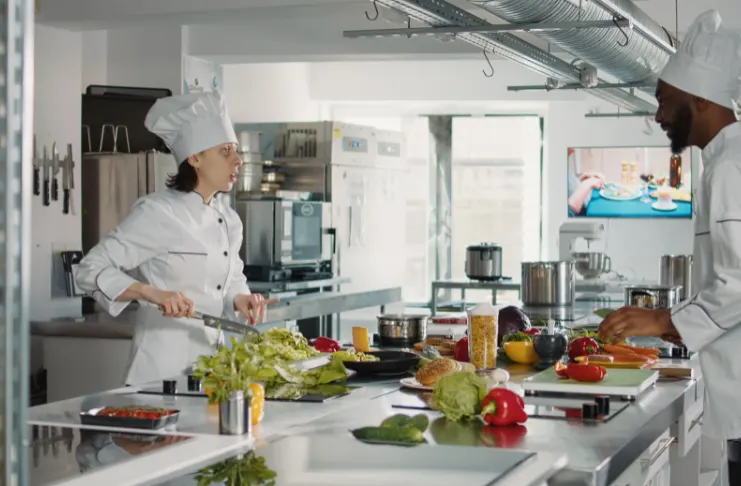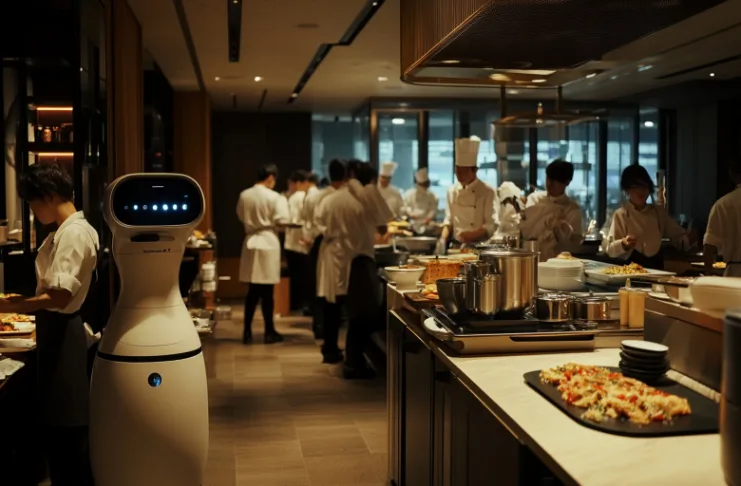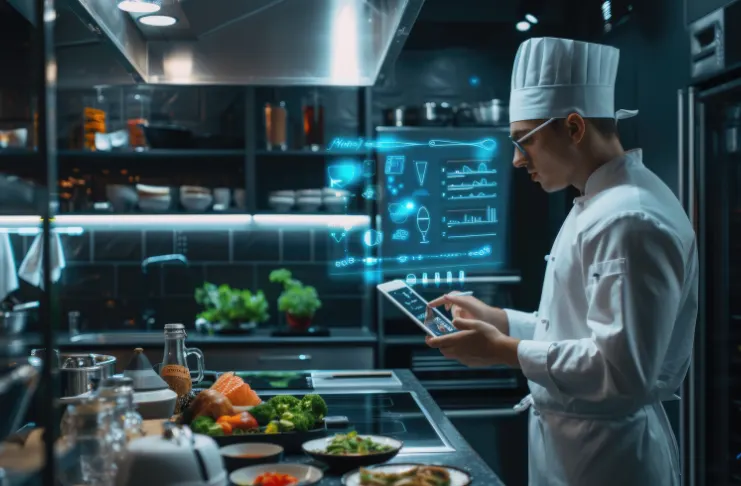The food service industry has undergone a revolutionary transformation with the emergence of popular cloud kitchen business models that are reshaping how restaurant businesses operate and serve customers, significantly affecting their profit margins. These virtual kitchens have become the backbone of modern food delivery, offering entrepreneurs innovative pathways to enter the competitive culinary market without the traditional overhead costs of brick-and-mortar establishments.
Cloud kitchens, also known as ghost kitchens or virtual restaurants, represent a paradigm shift in food service delivery that has gained unprecedented momentum globally, heavily relying on emerging restaurant technology. The concept eliminates the need for physical dining spaces, focusing entirely on food preparation and delivery operations. This model has proven particularly attractive to both established restaurant chains looking to expand their reach and new entrepreneurs seeking cost-effective entry points into the food industry.
The rise of popular cloud kitchen concepts has been accelerated by changing consumer behaviors, technological advancements, and the increasing demand for convenient food delivery market options. These virtual kitchens operate from commercial spaces optimized for food production, often housing multiple restaurant brands under one roof to maximize efficiency and total revenue through increased food sales.
Understanding the landscape of top cloud kitchen models worldwide is crucial for anyone considering entry into this rapidly growing sector influenced by market trends. The diversity of successful approaches demonstrates that there is no single formula for success, but rather multiple pathways that can be tailored to specific markets, cuisines, and target demographics.
Understanding Cloud Kitchen Fundamentals
Popular cloud kitchen concepts are revolutionizing the food industry by focusing solely on delivery-first operations, which is appealing to restaurant owners. These models offer a lean, tech-driven alternative to traditional restaurants that can help achieve a healthy restaurant profit margin. Key features include:
- Delivery-only format cuts costs by eliminating dine-in spaces and front-of-house staff.
- Strategic kitchen layouts and automation improve production speed and efficiency.
- Technology integration ensures smooth order processing and real-time delivery tracking.
- Location selection is optimized to reduce delivery times and reach high-demand zones.
- Aligned with consumer demand for convenient, restaurant-quality food at home or work.
By prioritizing cost-efficiency and operational scalability, successful cloud kitchen business ideas meet modern dining expectations while maximizing profit potential through cost savings .
Top Cloud Kitchen Models Worldwide

Discover the top cloud kitchen models worldwide—from multi-brand virtual restaurants and franchise-based systems to corporate ghost kitchens and independent artisan concepts—each offering unique advantages to thrive in the booming global cloud kitchen market through effective menu engineering .
Multi-Brand Virtual Restaurants
One of the most popular cloud kitchen concepts is the multi-brand cloud kitchen model, where several virtual restaurant brands operate from a single kitchen. This approach offers efficiency, flexibility, and diverse revenue streams, particularly through direct online ordering :
- Multiple brands run from one kitchen to serve varied cuisines and customer segments.
- Shared ingredients and prep processes reduce food waste and streamline operations.
- Ideal for testing new cloud kitchen business ideas with minimal upfront investment.
- Consumers accept digital-only brands if quality and delivery meet expectations.
- Highly effective in urban areas with strong demand for food delivery and variety.
This model exemplifies how top cloud kitchen models worldwide maximize ROI through smart brand strategy and efficient resource use, including effective partnerships with food delivery platforms.
Franchise-Based Cloud Kitchen Systems
Franchising is one of the most successful cloud kitchen business ideas, offering a lower-risk entry point for entrepreneurs by leveraging established brands and food delivery services. Key benefits include:
- Offering Catering services
- Access to proven brand equity, supply chains, and marketing support.
- Franchise-specific adaptations for delivery-only operations, including streamlined menus and specialized packaging.
- Reduced startup risk compared to independent cloud kitchens.
- Turnkey operational systems suited for rapid scaling.
- Ideal for investors seeking top cloud kitchen models worldwide with built-in customer trust.
With strong backing and digital-first strategies, franchise cloud kitchens offer a scalable path to success in the growing online food delivery virtual restaurant space.
Corporate Ghost Kitchen Networks
Corporate ghost kitchen networks are a high-capacity evolution of popular cloud kitchen concepts, built for efficiency and nationwide scale. These delivery-only models are reshaping the industry with:
- Centralized menu development and standardized operations across all locations.
- Advanced tech platforms for managing multi-location performance and logistics.
- Backing from major investors and food service corporations seeking scalable growth.
As one of the top cloud kitchen models worldwide, the corporate approach delivers consistency, speed, and reach, ideal for brands aiming to dominate multiple markets, unlike traditional restaurants.
Independent Artisan Concepts
Independent artisan kitchens offer a creative, grassroots take on popular cloud kitchen concepts, appealing to niche audiences through unique culinary identities within the food business. Key features include:
- Focus on specialty cuisines, dietary-specific menus, or innovative fusion dishes.
- Strong customer engagement through social media presence and word-of-mouth marketing.
- Emphasis on brand identity, food quality, and personalized service over scale.
This model supports successful cloud kitchen business ideas that value creativity and customer connection, especially in the context of the rise of cloud kitchens.
Global Trends in Cloud Kitchens

Let’s dive into the key global trends shaping cloud kitchens today—technology innovation, sustainability, health focus, and strategic expansion—and see how each is driving success in this dynamic industry.
Technology-Driven Innovation
Technological innovation is a key driver among global trends in cloud kitchens, particularly through the development of food delivery apps, boosting both efficiency and customer satisfaction. Highlights include:
- AI and machine learning improve order forecasting, restaurant inventory software management, and customer service.
- Automation—like robotic prep and smart packaging—cuts food and labor costs and ensures consistent quality.
- IoT devices enable real-time monitoring of equipment, food safety, and energy use for optimized operations.
These tech advancements empower successful cloud kitchen business ideas to scale profitably while meeting modern consumer expectations.
Sustainability and Environmental Consciousness
Environmental sustainability is becoming a vital focus in popular cloud kitchen concepts, helping operators attract eco-conscious customers. Key trends include:
- Adoption of eco-friendly packaging, waste reduction, and energy-efficient equipment.
- Emphasis on local sourcing and seasonal menus to reduce costs and support communities.
- Carbon footprint reduction through optimized delivery routes, EV partnerships, and renewable energy use.
These green initiatives strengthen brand reputation and align with global trends in cloud kitchens focused on responsibility and profitability.
Health and Wellness Focus
Health and wellness are shaping global trends in cloud kitchens, driving menu innovation and customer transparency. The Plant-based Food Market in the US is predicted to gain over $19 billion by 2030. Key developments in this include:
- Menus featuring plant-based, low-carb, and functional foods aligned with wellness goals.
- Increased focus on nutritional transparency, detailed ingredient sourcing, and allergen information.
- Popularity of meal customization and build-your-own options to meet diverse dietary needs.
These trends are essential for successful cloud kitchen business ideas aiming to attract health-conscious consumers through online food ordering and to stay competitive.
Market Expansion and Geographic Diversification
Geographic expansion is a key strategy among popular cloud kitchen concepts, enabling rapid growth and market penetration. Key points include:
- Operators adapt menus and operations to local tastes while preserving core brand identity.
- Emerging markets with rising middle classes and improving delivery infrastructure offer high growth potential.
- Cross-border franchising and licensing help scale top cloud kitchen models worldwide through local partnerships.
This expansion approach is critical for successful cloud kitchen business ideas aiming to build a global presence efficiently.
Together, these global trends—technology innovation, sustainability, health focus, and strategic expansion—are driving the evolution and success of cloud kitchens, empowering operators to meet changing consumer demands while scaling efficiently in a competitive market.
Successful Business Ideas and Concepts

Cloud kitchens are reshaping food delivery with authentic ethnic flavors, health-focused menus, indulgent comfort foods, and fast-casual favorites—each redefining the way we eat.
Ethnic and Regional Cuisine Specialists
Specialized ethnic and regional cuisines are among the most successful cloud kitchen business ideas, appealing to niche audiences and food lovers seeking authenticity without a physical location. Key highlights include:
- Authentic recipes and traditional methods cater to cultural communities and adventurous eaters.
- Strong brand loyalty is often built by operators with deep cultural ties to the cuisine.
- Regional American favorites like Southern comfort food and Tex-Mex thrive in delivery-focused models.
These focused concepts are a powerful part of popular cloud kitchen concepts, meeting diverse consumer demands worldwide.
Health-Focused and Dietary-Specific Concepts
Health-focused cloud kitchen concepts are rapidly growing as more consumers seek nutritious and convenient meal options. Key trends include:
- Specialization in diets like keto, paleo, vegan, and Mediterranean for targeted nutrition.
- Meal prep and portion-controlled options catering to busy, health-conscious customers.
- Functional foods featuring superfoods, adaptogens, and anti-inflammatory ingredients.
These concepts are among the most successful cloud kitchen business ideas, meeting the rising demand for wellness-driven dining.
Comfort Food and Indulgent Concepts
Despite the rise of health-focused menus, comfort food remains one of the most popular cloud kitchen concepts, especially for late-night and weekend orders. Key points include:
- Elevated classics like gourmet burgers, artisanal pizzas, and indulgent desserts attract customers.
- Success relies on creative twists, premium ingredients, and visually appealing presentation.
- Dessert-only kitchens specializing in cookies, cakes, and ice cream tap into impulse and special occasion demand.
Comfort food concepts continue to be a staple among successful cloud kitchen business ideas, balancing familiarity with innovation.
Fast-Casual and Quick-Service Adaptations
Fast-casual and quick-service concepts are thriving as popular cloud kitchen concepts, adapting menus and operations for delivery efficiency without sacrificing quality. Key highlights include:
- Streamlined menus and prep processes boost speed and reduce costs while preserving customization.
- Quick-service brands simplify offerings and optimize packaging for delivery success.
- Breakfast and brunch-focused kitchens capitalize on growing at-home and office consumption trends.
These adaptations make fast-casual and quick-service among the most successful cloud kitchen business ideas today.
Leverage Technology and Innovation Drivers

Technology-driven innovation is reshaping popular cloud kitchen concepts, enhancing efficiency, consistency, and customer satisfaction through advanced AI, automation, and data analytics.
Artificial Intelligence and Machine Learning
Artificial intelligence is revolutionizing popular cloud kitchen concepts, driving efficiency and enhancing customer experiences. Key applications include:
- Predictive analytics and demand forecasting optimize inventory and reduce waste.
- Machine learning analyzes ordering trends to improve staffing and menu planning.
- NLP-powered chatbots automate customer service, handle orders, and gather feedback.
These AI-driven innovations support successful cloud kitchen business ideas by enabling smarter, data-driven operations.
Automation and Robotics Integration
Kitchen automation is a game-changer in popular cloud kitchen concepts, boosting speed, consistency, and operational control. Key trends include:
- Robotic systems automate food prep, portioning, and packaging for high-volume efficiency.
- Integrated inventory management reduces manual tasks and streamlines supply chains.
- IoT-enabled smart cooking equipment allows remote monitoring and quality control.
These restaurant techs enhance scalability and boost profitability, making automation vital for successful cloud kitchen business ideas.
Data Analytics and Performance Optimization
Advanced data analytics are transforming popular cloud kitchen concepts by delivering actionable insights for improved performance. Key benefits include:
- Integration of sales, delivery, and feedback data for comprehensive operational visibility.
- Real-time monitoring and alerts to quickly resolve issues and maintain quality.
- Predictive analytics to forecast demand, optimize pricing, and guide expansion decisions.
Leveraging data analytics empowers successful cloud kitchen business ideas to drive growth and enhance customer satisfaction by optimizing the restaurant’s offerings.
Operational Excellence Strategies

Smart kitchen design, rigorous quality control, and strategic supply chain management are fundamental pillars that drive efficiency and reliability in successful cloud kitchen operations.
Kitchen Design and Workflow Optimization
Effective kitchen design is key to successful cloud kitchen business ideas, driving efficiency and quality. Key elements include:
- Optimized layouts that streamline food prep, packaging, and order fulfillment.
- Workflow strategies that reduce movement and prevent bottlenecks during busy times.
- Strategic equipment selection focused on high throughput, energy efficiency, and durability.
Well-designed kitchens support operational excellence and scalability within popular cloud kitchen concepts.
Quality Control and Food Safety
Comprehensive quality control is vital for successful cloud kitchen business ideas, ensuring food safety and customer satisfaction. Key components include:
- Standardized recipes, portion control, and temperature monitoring for consistent quality.
- Specialized packaging and handling protocols are used to maintain safety during delivery.
- Staff training focused on food safety, quality standards, and efficient prep techniques.
Robust quality systems are essential to building trust and reliability within popular cloud kitchen concepts.
Supply Chain Management
Strategic supplier relationships are essential for successful cloud kitchen business ideas, ensuring quality and cost-efficiency. Key points include:
- Partnerships with multiple suppliers guarantee consistent ingredient quality and availability.
- Integrated inventory management minimizes waste and streamlines ordering.
- Local sourcing offers fresher ingredients and appeals to sustainability-minded consumers.
Strong supplier management supports operational excellence within popular cloud kitchen concepts.
Marketing and Customer Acquisition

Digital marketing, customer loyalty programs, and strategic partnerships are key growth drivers that help cloud kitchens build strong brands, retain customers, and expand their market presence.
Digital Marketing Strategies
Digital marketing drives growth for popular cloud kitchen concepts by increasing brand visibility and customer acquisition. Key tactics include:
- Leveraging social media to showcase menus, share testimonials, and engage audiences with visual content.
- Using SEO and content marketing to boost online discoverability and organic traffic.
- Partnering with influencers and food bloggers to build credibility and reach niche markets.
Effective digital marketing fuels order volume and brand awareness in successful cloud kitchen business ideas.
Customer Retention and Loyalty Programs
Customer retention is crucial for sustained success in popular cloud kitchen concepts. Effective strategies include initiatives aimed at fostering repeat business :
- Loyalty programs and personalized offers to encourage repeat orders and enhance customer lifetime value.
- Email marketing and push notifications to promote new menu items and targeted deals.
- Systems for collecting and responding to customer feedback to improve satisfaction and build trust.
Strong retention programs help cloud kitchens maintain steady revenue and positive reviews.
Partnership and Collaboration Opportunities
Strategic partnerships expand reach and revenue for successful cloud kitchen business ideas by tapping into new customer segments and retaining existing customers. Important opportunities include:
- Collaborations with delivery platforms for wider market access and marketing support.
- Corporate catering and office delivery agreements providing steady, higher-value orders.
- Cross-promotions with local businesses and lifestyle brands to increase brand visibility.
Partnerships play a vital role in scaling and diversifying popular cloud kitchen concepts.
Financial Models and Investment Analysis

Launching, pricing, and scaling popular cloud kitchen concepts require strategic financial planning and operational efficiency to ensure profitability and sustainable growth.
Startup Costs and Capital Requirements
Launching popular cloud kitchen concepts requires a lower initial investment than traditional restaurants and demands careful financial planning. Key points include:
- Equipment costs range from $50,000 to $150,000+, depending on menu complexity and scale.
- Operating expenses like rent and utilities are ongoing but require upfront cash flow coverage.
- Initial inventory and working capital must be budgeted to sustain operations during the launch phase.
Adequate capitalization is critical to successfully starting and scaling a successful cloud kitchen business.
INDUSTRY INSIGHT
| According to CloudKitchens, major U.S. food delivery platforms like DoorDash, Uber Eats, and Grubhub charge commission fees typically ranging from 15% to 30% per order. This makes it essential for restaurant operators to optimize pricing strategies and encourage direct ordering channels. |
Revenue Models and Pricing Strategies
Effective revenue models and pricing are vital for the profitability of popular cloud kitchen concepts. Important considerations include:
- Menu pricing that balances food costs, delivery commissions, and competitiveness.
- Maximizing order frequency and average order value through upselling and customer retention programs.
- Diversifying revenue streams with multiple delivery platforms, direct orders, catering, and retail partnerships.
Strategic pricing and diversified income support sustainable growth in successful cloud kitchen business ideas.
Profitability Analysis and Growth Projections
Profitability in popular cloud kitchen concepts depends on efficient cost control and volume growth. Key factors include:
- Achieving profitability typically within 6-18 months by optimizing order volume and operational efficiency.
- Monitoring KPIs like average order value, customer acquisition cost, and food cost percentages for informed decision-making.
- Planning expansion through multiple locations, virtual brands, and new markets to drive scalable growth.
Continuous financial and operational optimization positions cloud kitchens for long-term success.
Challenges and Risk Management

Cloud kitchens face a unique set of operational, competitive, and regulatory challenges that require strategic planning and agile management to ensure consistent quality and understanding of how to run a profitable restaurant.
Operational Challenges
Cloud kitchen operators face several critical challenges that impact their ability to deliver consistent quality and timely service, especially when trying to run their own business .
- Maintaining consistent food quality and preparation speed during peak times requires effective staffing, optimized workflows, and strong quality control systems.
- Supply chain disruptions demand backup suppliers, flexible menus, and smart inventory management to avoid service delays.
- Technology failures can cripple operations; having backup systems, redundant internet, and manual processes is crucial to minimize downtime.
Successfully managing these challenges is key to smooth, reliable cloud kitchen operations.
Market Competition and Differentiation
In a rapidly expanding cloud kitchen market, standing out and maintaining loyal customers poses a significant challenge.
- Intense competition in the cloud kitchen space requires clear differentiation and unique value propositions to stand out.
- Changes in delivery platform algorithms and policies necessitate marketing diversification to avoid overreliance on any single channel.
- New entrants and established chains expanding into delivery drive the need for continuous innovation and operational excellence.
A strong competitive strategy ensures sustained visibility and customer loyalty in a crowded market.
Regulatory and Compliance Considerations
Operating cloud kitchens requires careful adherence to evolving food safety, zoning, and labor regulations to ensure smooth and legal business operations.
- Cloud kitchens must comply with food safety regulations, including inspections and thorough documentation, just like traditional restaurants.
- Zoning and land use laws are evolving, with some areas imposing permits or restrictions specific to virtual kitchens.
- Labor laws—minimum wages, overtime, and benefits—must be managed carefully to maintain profitability while ensuring legal compliance.
Navigating these regulatory requirements is essential for stable and lawful cloud kitchen operations.
Future Outlook and Opportunities
Popular cloud kitchen concepts are driving a major shift in food service, fueled by consumer demand, tech innovation, and market scalability. Key global trends in cloud kitchens include:
- Projected annual growth of over 10% in mature markets.
- Rapid expansion in emerging regions due to rising smartphone use and delivery infrastructure.
- Increased investor interest in scalable, successful cloud kitchen business ideas.
- Use of automation, AI, and blockchain for efficiency and transparency.
- Push toward sustainable packaging and eco-friendly operations.
- Growth of hybrid models and consolidation among top cloud kitchen models worldwide.
Cloud kitchens aren’t a trend—they’re a long-term evolution in the restaurant business. Operators who embrace innovation and efficiency are best positioned for lasting success.
Conclusion
Cloud kitchens are transforming the food service industry by offering innovative and cost-effective solutions that cater to the growing demand for convenient meal delivery. Their emphasis on operational efficiency, advanced technology integration, and flexible business models enables operators to deliver high-quality food quickly and reliably. This delivery-first approach meets the evolving preferences of modern consumers who prioritize speed and convenience without compromising on quality.
As virtual kitchens expand globally, understanding the strategies behind successful cloud kitchen concepts becomes vital for both new entrepreneurs and established restaurant brands. Multi-brand facilities, streamlined operations, and targeted digital marketing play a crucial role in driving growth and increasing restaurant sales while reducing overhead costs. These advantages allow cloud kitchens to scale rapidly and adapt to changing market conditions, making them a compelling alternative to traditional restaurant models.
Embracing the cloud kitchen model provides significant opportunities to increase profitability and capture new customer segments. By focusing on innovation, quality control, and customer engagement, operators can create a restaurant model that generates high profit margins and thrives in today’s competitive food delivery ecosystem. For anyone seeking to succeed in the evolving restaurant industry landscape, cloud kitchens offer a modern, efficient path to sustainable growth and market relevance.
Frequently Asked Questions
1. What is the concept of cloud kitchen?
A cloud kitchen is a delivery-only restaurant that operates without a dine-in space.
2. What is a ghost kitchen concept?
A ghost kitchen is a virtual kitchen focused solely on food delivery, often housing multiple brands.
3. What is the minimum budget for a cloud kitchen?
The minimum budget for a cloud kitchen typically starts around $50,000 to $100,000.
4. What is the cloud cook concept?
The cloud cook concept involves chefs preparing food exclusively for delivery through virtual kitchens.
5. What is the largest cloud kitchen brand in the world?
Rebel Foods is considered the largest cloud kitchen brand globally.
6. Who is CEO of CloudKitchens?
Travis Kalanik is the CEO of CloudKitchens.
7. How many locations does CloudKitchens have?
CloudKitchens operates over 40 locations worldwide.
8. How much money do cloud kitchens make?
Cloud kitchens can make from $250,000 to over $1 million annually, depending on scale.
9. Is CloudKitchens profitable?
Profitability varies; some cloud kitchens are profitable within 6-18 months of launch.
10. What food is most ordered in cloud kitchens?
The most ordered foods are pizza, burgers, and Asian cuisines in cloud kitchens.
11. How successful are cloud kitchens?
Cloud kitchens are growing rapidly and show strong success in urban markets.
12. How much can a cloud kitchen make?
A cloud kitchen can earn between $500,000 to several million dollars yearly depending on size and location.





